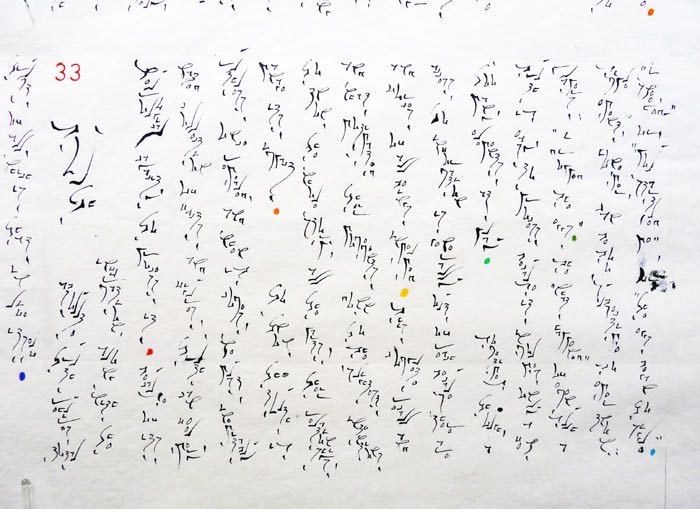HD e-Books & text for sale <—> www.ccelian.com
the Art of Nao
< Scroll 28 ___________________________________________________ Scroll 30 >


Scroll 29 . 92 x 171 cm ~236 x ~ 67 inches
_____________________________

Scroll 29-section 1.1
> already agreed to give them the benefit of the doubt, and so start to trust them.
The underlying assumption for trust in another person is that each one cares about their own authenticity. This is not always the case, and knowing whom to trust, and when, is at the heart of a smooth social life. The delicate balance is to become neither so trustful as to trust universally, nor so skeptical as to trust no one, even when they deserve it.
The smaller the community in which we grow up, the more likely we are to trust new people since we will have had a limited range of occurrences from which to have reasons for mistrust. By contrast, acting with blanket trust in a large city is predictably going to provide someone with an opening to abuse it. That is why visitors from smaller urban areas to larger ones are often easily taken advantage of.
Consequently, the long-term urbanite's nervous system is constantly shielded—to the point that many live in a permanent state of skepticism as to any stranger’s motives.
________________

Scroll 29-section 1.2
As a general principle, the more we have to protect our nervous system from access, the more we will mistrust others and, as a side effect, the less we can conduct a fully open relationship with ourselves.
Degrees of Trust
The ultimate “prove it” distrusters are scientists; they will not entrust their neurology to anything untested. This attitude is not maladaptive cynicism but instead, mistrust vis à vis the unproven. The force that we give to a scientific statement comes specifically from our assumption that its conclusions originate from a consciousness with high standards for its trust in information. In a rather fair way, the sciences do not expect our trust until they have offered solid proof.
Unlike science, religions presume an enormous amount of trust from their adherents since no belief system with words alone can prove that their cosmology is universally true. Religions must always >
___________________

Scroll 29-section 2.1
> lobby for our trust since they do not have a stand-alone product.
As with any belief system, a religion is built on the basis of a trust that may never have the opportunity to justify itself. Under such conditions, any proof as to a religion’s “truths” can only occur inwardly, on an individual level, which is not something that you can hand over to someone else.
Thoughts, feelings, imaginations, all fill our ungraspable inner world, the specifics of which must always be reenacted, and privately so. An object in mind has to be newly imagined every time that we think of it; there is no inner shelf to which we can return in the expectation of finding a previous thought still there. We cannot take a photograph of our inner space and show its contents to someone else. All that we can do is to express it, or act under its influence.
The collective nervous system of a society can also be described in terms of its trust quotient, which corresponds to the degree of trust that its members have in both its systems of government and in one another.
________________

Scroll 29-section 2.2
The more this trust is taken for granted, the more civilized is the society. Conversely, the more guarded and anarchic its members are, the less civilization a society can claim to have.
Since trust comes from the full delivery of information, what trust needs in order to be solid, is indistinguishable from transparency—something also essential in relationship to our self. As the saying goes: “Ethical behavior is doing the right thing when no one is watching—even when doing the wrong thing is legal.”
To act from a position that presumes all we do is eventually visible to some form of consciousness—if only our own—literally clarifies us to behave in ways that will be beneficial to all in the long run.
This is not a rule to live by so much as, a necessary element for a full life.
_________________

Scroll 29-section 3.1
Unless we act ethically in relation to ourselves and to others, we cannot trust anyone at those levels where trust makes a critical difference as to action vs non-action. Interestingly, living with self-transparency has the same result as if we were being good on purpose, only without having to correlate our behaviour to a belief system for what good looks like in contrast to bad.
Instead, we can simply be as we are, without apology or justification. In that ongoing state we can trust ourselves, know whom to trust, and cannot help but inspire trust in others. What follows from this way of being is a natural internal alignment. At one end of it there is infinite access to the +crossfield of information and, at the other, yet another present for us to experience and modulate; in the middle, are our specific goals. Once we see this mechanism flow, we can exercise the largest trust of all, which is that in life itself.
___________________

Scroll 29-section 3.2
33 Truth
Absolute truth requires total information, along with the neurological capacity to process it. Because of its naked collection of facts and motives, truth can feel very ruthless once revealed, and when it comes, we must inevitably manage its impact.
To know the truth is to know the whole story, all the parts, their relationships, and what motivated their movements down to the slightest intentions and forces of all beings involved. This complete recall and access to information is generally out of reach because there are too many elements to include.
Sometimes, though, a truth is easy to process because it involves only a few players: “I dropped the eggs.” The “what happened” of even such a simple event, however, can be too subjective to ever know: “I sneezed.” “You startled me.” “The eggs began to jiggle.”
____________________

Scroll 29-section 4.1
Because some people’s nervous system has an above average sensitivity, they may be aware of a truth even as others firmly deny its existence. Along the same lines, a person may perceive something accessible only to them, such as hallucinations, or perhaps other dimensions of life. In either case, the truth remains elusive for the group and certain for the individual.
The consequence flowing from truth’s dependence upon both information and its incorporation into perception is that: although we can agree on truths noticeable to all (rain falls from the sky), we cannot always agree on truths that depend upon internal states for perception.
As a variation on the theme of truth, if we are unable to perceive something’s existence, then we cannot assert its truth, even if there might be a potential for this under other circumstances.
Some birds see beyond the spectrum of visible light and perceive the ultraviolet wavelengths of flowers.
________________

Scroll 29-section 4.2
If, in ignorance of this fact, we insist that no such floral wavelength exists, are we lying or telling the truth? Where lies the truth when we all agree on a lie founded upon misinformation?
There are many global conditions that are of concern to us as empathetic beings: hunger, wars, sustainability, and sad to say, much more. We have differing ”truths” on these subject matters because we are acting out of unique personal + cultural nervous systems.
Some truths can be measured by a simple "yes" or "no" because they are clearly absolute states of being. Is a person pregnant or not? Or how about: is there a ghost in the room? This last question cannot always be answered in a clear way. The neurology of some people registers the presence of a being whom others do not see, like children with their imaginary friends.
How can a person who does not perceive that someone else is in the room agree that the other who does see them is telling the truth? The fact is that the truths of inner realities are well >
_____________________

Scroll 29-section 5.1
> beyond the reach of external measurements and can only be shared when another person says: ”me too."
Is it the truth that reality is malleable to the extent of being transformable by anyone and at will? Since truth is based upon neurological activity, the answer to this question emerges from personal experience. Whether all or a few say that it is true, the truth of a self-determined reality can only reveal itself within each of our own lives.
The point of being able to transform reality is relevant to our own personal experience. As long as we achieve our desired results, it makes no practical difference if others believe that a flexible reality is true or not.
___________________

Scroll 29-section 5.2
When we act on what is true for us, then the degree of success, of joy, of vitality, and of love for life that follows is a far better determinant of our truth’s validity than any other based upon another’s claims to the contrary.
34 Kinds of Meanings
Part I
Anything at all can become meaningful as long as our nerves experience it that way.
When we say that something gives our life meaning, it is due to how many levels of our neurology it engages. Just as different >
___________________

Scroll 29-section 6.1
> roads take us to vastly different places and situations, by their pathways, neurological relationships cause us to perceive a range of meanings.
The word “mean-ing” is the active form of the same term “mean” that we encounter in mathematics where it is used to describe the average amount for a range of values regarding a given set of measurements. Similarly, the meanings that we ascribe to experiences, things, words, etc., are their average values for us as computed by our nerves’ electrical accounting.
The word “piano” triggers a different meaning (and set of synapses) in someone who plays it on world stages than it does in a non-musician. Likewise, the meaning of “parent” activates different synapses in someone who has children than in one who doesn’t.
The more meanings we are capable of conceiving, the more complex and vast our nervous system will, and must, be.
_______________

Scroll 29-section 6.2 — End of Scroll 29
This neurological intricacy does not necessarily guarantee a logical relationship within the elements that add up to a meaning, as when a paranoid sees threats in innocent objects and events.
The reverse engineering of meaning’s neurological structure is: change what something means and you’ve redirected your nerves’ electrical firings and connections; start by changing your nerves’ pathways and you’ve automatically change meanings. Any alteration in a given meaning will also shift every subject matter’s meanings that are dependent upon it.
Neurological connections are not just the medium by which we experience meaning, without them, no meaning can take place. Concepts can dissolve when neurological connections disappear due to a new understanding, new information, maturity, and >
< Scroll 28 ____________________________________________________ Scroll 30 >
Scrolls: 1 . 2a . 2b . 3 . 4 . 5 . 6 . 7 . 8 . 9 . 10 . 11 . 12 . 13 . 14 . 15 . 16 . 17 .
18 . 19 . 20 . 21 . 22 . 23 . 24 . 25 . 26 . 27 . 28 . 29 . 30 . 31 . 32 . 33 . 34 .
Buy HD e-Books & Text —— www.ccelian.com
© C.C. Elian 2010 - 2016